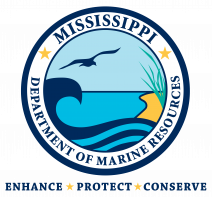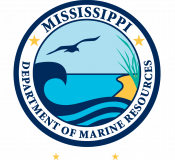COASTAL PRESERVES
- Laura Moncrief, Director
- (228) 523-4149
- laura.moncrief@dmr.ms.gov
As part of the development of the Coastal Preserves Program, 72,000 acres of tidal marsh, tidally influenced marsh and wetlands were designated as “crucial coastal wetlands habitat” within 20 unique Coastal Preserve sites. The state currently holds title to about 40,000 acres of this crucial coastal wetland habitat. MDMR partners with the Mississippi Secretary of State’s office, which acquires the properties, and MDMR manages the lands for the state. A description of the 20 designated Coastal Preserves can be found below. The Coastal Preserves Program also manages five trail systems within several Coastal Preserves sites: Indian Point trails in Gautier, Deer Island trails in Biloxi, Ansley Birding Trail in Hancock County, Bell’s Ferry Nature Trail off the Wolf River in Pass Christian; and 12 Oaks Trail in Ocean Springs, which is managed jointly with the Land Trust for the Mississippi Coastal Plain.
COASTAL PRESERVES INFORMATION
Coastal Preserves Mission, Vision, and Goals
Mission
The Coastal Preserves Program is dedicated to effectively preserve, conserve, restore, and manage Mississippi’s coastal ecosystems to perpetuate their natural characteristics, features, ecological integrity, social, economic and aesthetic values for future benefit.
Vision
The long-term vision of this program is the management of Mississippi’s Coastal Preserves sites to provide long-term benefits to the natural resources and economic value of the region. Management goals will enhance and perpetuate approximately 83,000 acres of important coastal wetland resources, provide compatible human recreational use, provide research and data applicable to coastal resource management both on-site and off-site, and protect specific habitat necessary for native, threatened, or endangered species. State trust lands within the Coastal Preserve sites will be effectively managed to perpetuate their natural characteristics, features, ecological integrity, social, economic, and aesthetic values so that future generations may enjoy the benefits of viable wetland ecosystems.
Goals
Coastal Preserves Program personnel will partner with the Mississippi Secretary of States Office, the Nature Conservancy, U.S. Fish and Wildlife Service, Grand Bay National Estuarine Research Reserve, Mississippi Forestry Commission, National Resource Conservation Service, and other local, state, and federal agencies and organizations to fulfill the responsibilities mandated in the Memorandum of Understanding between the Department of Marine Resources and the Secretary of States Office.
1. Restore, enhance, protect, and manage Mississippi’s remaining coastal estuarine marsh ecosystems.
Objective: Acquire and protect coastal habitats.
Strategy: Identify, acquire, and protect significant acreage of high priority coastal wetlands through fee simple title, easements, or protective agreements each year.
Objective: Identify coastal wetlands that can be restored or enhanced to mitigate adverse impacts to coastal habitats.
Strategy (1): Implement measures to identify wetlands that have been altered and can be restored or enhanced to perform wetland functions.
Strategy (2): Identify, create, restore, or enhance significant acreage of high priority coastal wetlands by 2008.
2. Protect and preserve habitat of any rare, threatened, or endangered species of plants and animals present on Coastal Preserves.
Objective: Protect and preserve habitat critical for rare, threatened, and endangered species.
Strategy (1): Assess and monitor occurrences and locations of rare, threatened, and endangered species within Coastal Preserve sites.
Strategy (2): Protect and preserve significant acreage of critical habitat required by rare, threatened, and endangered species through fee simple title, easements, or protective agreements each year.
Strategy (3): Manage habitat of rare, threatened, and endangered species to prevent impacts that would negatively influence ecological integrity.
3. Promote increased opportunities for public appreciation and enjoyment of Mississippi’s coastal estuarine wetlands that are compatible with protecting, preserving, and enhancing the natural resources.
Objective: Provide public access and use of resources on state-owned lands within Coastal Preserves Program.
Strategy (1): Identify those areas conducive to increased public access and enjoyment of wetland resources within Coastal Preserve sites.
Strategy (2): Provide public opportunities for hunting, fishing, and other outdoor recreational opportunities.
Strategy (3): Develop necessary partnerships with state and local agencies to finance, develop, and manage enhanced access projects.
Strategy (4): Secure necessary acreage to protect unique habitat and environmentally sensitive areas.
Objective: Actively promote access and enjoyment opportunities of public wetland sites.
Strategy (1): Identify and inventory coastal wetland sites that provide public access and recreational opportunities.
Strategy (2): Develop a comprehensive guide promoting opportunities to public access facilities and the natural resources of Mississippi Coastal Wetlands.
Strategy (3): Develop partnerships with other natural resource agencies, state agencies, and local private organizations to promote opportunities for public enjoyment of coastal wetlands.
Strategy (4): Provide public opportunities to participate in wildlife and habitat inventories and surveys.
4. Acquire, restore, and protect unique habitats associated with plant and animal communities.
Objective: Identify unique habitats within the Coastal Preserve sites.
Strategy (1): Use photographs, literature, and field visits to identify and inventory habitats and communities located within the Coastal Preserve sites.
Strategy (2): Document and collect coordinates for unique habitats and communities.
Objective: Acquire and protect unique habitats and communities.
Strategy (1): Acquire significant acreage of unique habitat and communities.
Strategy (2): Develop management plans that preserve ecological integrity of habitat.
Strategy (3): Evaluate land use management strategies.
Strategy (4): Identify unique or critical habitat that may not reside within Coastal Preserves boundaries but may be suitable for acquisition or protection.
5. Monitor populations of non-indigenous species and protect native species from deleterious effects of non-indigenous species.
Objective: Identify, document location of, and monitor populations and effects of non-indigenous species on native flora and fauna.
Strategy (1): Semi-annually, determine if non-indigenous species are significantly threatening flora and fauna and take responsive actions annually to alleviate those threats.
6. Contribute to the viability and natural biodiversity of coastal estuarine marsh ecosystems through management.
Objective: Manage Coastal Preserves to support priority habitats and species and to promote environmental education and public use.
Strategy (1): Manage Coastal Preserve lands in a manner that will maximize their viability, biodiversity, and contribution to achieving ecosystem goals.
Strategy (2): Develop and maintain a coordinated Coastal Preserves data management system.
Strategy (3): Manage and develop provisions for the protection of areas containing unique examples of coastal estuarine marsh ecosystem and other significant natural features or plant or animal life.
7. Develop coastal preserve management strategies that foster improved coordination among federal, state, and local entities with jurisdiction and interests in coastal wetland protection.
Objective: Gather and make available information needed by reserve managers and coastal decision-makers for improved understanding and management of coastal resources.
Strategy (1): Enhance scientific understanding of estuarine ecosystem processes and functions.
Strategy (2): Collect important baseline data to monitor differences over time and for comparing different areas.
Strategy (3):Identify priority resources and monitor the impacts of human stresses.
Strategy (4): Maintain effective management activities and develop effective mechanisms for accountability.
Strategy (5): Establish a multi-disciplinary management advisory.
Objective: Make Coastal Preserve management processes visible, coherent, accessible, and acceptable to the people of Mississippi.
Strategy (1): Actively engage the state, local government, and local citizens early in the formulation and development of all Coastal Preserves Program ecosystem management activities.
Strategy (2): Provide opportunities for public review and comment to all proposed management actions.
Strategy (3): Promote opportunities to involve public stewardship in proposed management actions.
Strategy (4): Provide timely updates on management changes.
8. Increase public awareness and interest in the values and functions of coastal wetlands, their habitats, and the ecosystems they are dependent upon.
Objective: Develop and deliver educational materials and programs to inform the public about wetland species, their habitats, and their value to human beings.
Strategy (1): Develop four public information brochures or pamphlets about coastal wetland protection programs and local wetland functions by 2008.
Strategy (2): Develop and deliver three educational programs per year that enhance public awareness and understanding of estuarine ecosystems and human effects on them.
Strategy (3): Develop and provide public use of Coastal Preserve lands for environmental education.
Strategy (4): Develop and participate on two public outreach and education programs in high priority resource areas by 2008.
Coastal Preserves Visitor Rules and Guidelines
TITLE 22, PART 19 – Rules and Regulations for the use of State-Owned Coastal Preserve Areas
Coastal Preserves Related Laws
Coastal Preserves FAQs
When can I visit Coastal Preserve Areas (CPAs)?
- CPAs are open from one hour before sunrise to one hour after sunset, with the exception of Deer Island and Cat Island, which are open for 24 hours.
Can I camp on Deer Island or Cat Island?
- Yes, camping is allowed on state-owned sand beach areas and is limited to seven consecutive days. You must also follow all applicable rules and regulations set by the Mississippi Department of Marine Resources (MDMR).
Can I camp on other Coastal Preserve Areas?
- Camping on CPAs, other than Deer Island and Cat Island, is considered on a case-by-case basis. Please contact the Coastal Preserves office at 228-523-4106 for further details.
Can I hunt and fish on Coastal Preserves?
- Yes, but all regulations and seasons set by the Mississippi Department of Wildlife, Fisheries and Parks are to be followed. Also, there are additional rules with regards to hunting near trails that are explained in detail in the visitor rules and regulations located on our website and the end of this document.
Can I spray or remove the vegetation in or on the water around my property?
- No, only a properly certified agent of the State or Local Government can apply herbicide to or remove non-native species from waterways. Please report any nuisance vegetation to MDMR Coastal Preserves.
Can I take plants, soil, seeds or artifacts from Coastal Preserve Areas?
- No, all plants, soil, seeds and artifacts on CPAs are considered state property and should be left in place. Metal detectors are prohibited on all CPAs.
Do I have to clean up my own trash on a Coastal Preserve Areas?
- Yes, CPAs are primitive areas and are considered “pack-in/pack-out” areas.
Can I set up a feeder on a Coastal Preserve?
- No, any feeders found will be removed by MDMR staff.
Can I erect a duck blind or deer stand on a Coastal Preserve?
- Portable stands and blinds are allowed but must be removed daily. Construction of permanent blinds is prohibited.
Are bicycles allowed on a Coastal Preserve?
- Yes, bicycles are permitted on designated trails.
Can I shoot fireworks on a Coastal Preserve?
- No, possession of any explosive substance, such as dynamite, fireworks, Tannerite or rockets, on any Coastal Preserve is prohibited.
Can I take my dog on the trails with me?
- Yes, but pets must always remain on a leash.
Can I use hunting dogs on a Coastal Preserve?
- Yes, but only if they are on a leash at all times. No unrestrained dogs will be allowed on a Coastal Preserve.
Can I drive vehicles on Coastal Preserves properties including ATVs, UTVs, dirt bikes, etc.?
- No, motorized vehicles are not allowed on Coastal Preserves. This includes airboats and amphibious vehicles in marsh areas.
I have property to sell/donate, is Coastal Preserves interested?
- Please contact us directly with information on the property you are interested in selling or donating.
Can I host an event on a Coastal Preserve?
- All events must receive a Letter of Permission from the Coastal Preserves Bureau prior to the event. It’s advisable to contact our office at least 60 days in advance of your proposed event date. Certain restrictions may apply depending on the specific preserve.
Click here to access the rules and regulations of the Mississippi Coastal Preserve Areas.


